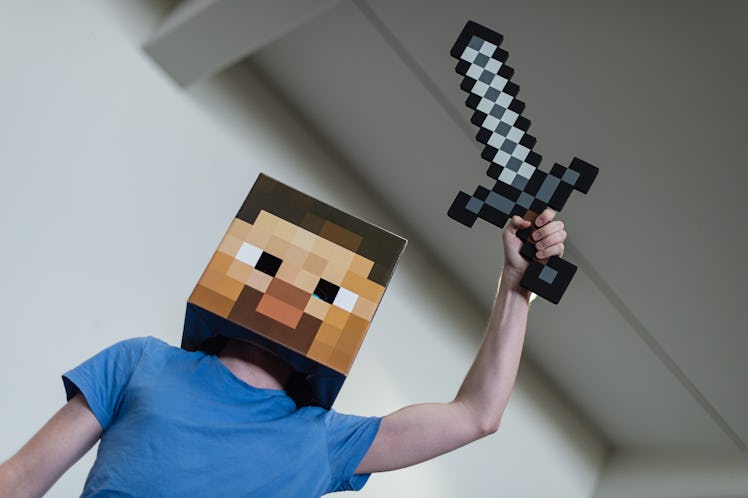A Parent’s Guide To Minecraft, According To A Cultural Anthropologist
Can you dig it?

You want to do some bonding with your kid over their favorite indoor activity: Minecraft. There’s one small problem: What the hell is a Minecraft? Before you start embarrassing yourself by telling your pre-teen and their friends that you’re hip to the lingo (that’s what uncool people have always said) better get yourself familiar with this video game that is a third LEGOs, a third coding, and a third youth subculture.
First, mine and craft are the 2 basic parts of the game. You dig for material. Then you build with it. But learning the basics such as “flying” and placing blocks in the game are difficult and time-consuming for most adults who already have zero free time. Luckily for you, just being able to check out your kid’s creations is going above and beyond the typical parent, says Mimi Ito, a cultural anthropologist at UC Irvine and one of the co-founders of a Minecraft summer camp for kids. You’ll be pleased to know that while she’s regarded as the foremost mind about this game, her kid is 10 times better at it than she is.
“I think it’s really valuable for parents to try to move around and see what the world is like from the kid’s point of view,” says Ito, who also says parents aren’t there to push their children out of the gaming chair, but rather to get invested and make sure things stay educational and cyber bully-free. “It’s easier to stay involved as an observer rather than someone who’s trying to acquire all the skills for themselves,” she says. So lay back, because your kid will appreciate the hell out of your effort to learn.
Take Some Flying Lessons
“Flying” is Minecraft speak for moving around quickly through the game. It’s an easy skill and the most important thing you can do to be involved in their digital life. It allows you to quickly cruise around the Minecraft landscape and see the buildings your kid has built, or the scarce resources they’ve managed to survive on. More on that below. “I have never mastered the mechanics of moving around,” Ito says. “But by watching YouTube videos and watching my son play, I at least understand what’s going on and can ask him informed questions.”
Learn The Rules Of The GameEverything about Minecraft is big, from the worlds to explore, to the architectural builds, to the number of YouTube channels dedicated to this thing. Fortunately, this isn’t ‘nam — there are rules. Learn the structure of the game first using these handy online guides:
Minecraft Guide: Parents Edition from Connected Camp: Explores the basics rules of the game, the different modes (like Survival, where you’re given 20 real minutes to gather supplies and build defenses before hordes come to loot and pillage. Or Creative, where you’re free to just make things like forts or the Burj Khalifa.) It will also teach you about the code of conduct that the camp gives its gamers, so you’re in the know about how kids pressure each other in competitive play.
Basics of Minecraft: In the game, recipes are used to make everything from different types of building material, to transportation, to magic potions. It’s complicated and there seems like an infinite variety of combinations to make different crap. Let your kid sort out what does what, you can have a faint inkling of what’s going on.
The Minecraft Glossary: Who is Steve? What is this biome? What is the Nether? Don’t ask questions you don’t want to know the answer to.
Oh, Bad Grief
As in many video games, Minecraft players can run around and chopping each other. It’s not like Grand Theft Auto, execution-style realism, but some incoming mobs or monsters can end things abruptly. It’s also the reason why cyber-bullying can occur even in something as seemingly innocuous as a building game.
“Griefing” is their word for bullying. And whether your kid is on the receiving end, or is the offender, there are only 2 ways to know. One is probably unreliable: They’ll tell you. The other is to ensure they are playing on a moderated server, like this free one when they’re in multi-player mode, which makes sure everyone is a responsible online citizen.
“Kids can learn bad online habits if they’re not in communities that are pro-social and friendly,” says Ito. “This is about being thoughtful and intentional when kids are starting to play. Parents want to make sure the multiplayer experience has a strong set of community values, so they don’t have to hover all the time.”
Host Your Own Server
If you don’t want to sort through the thousands of servers to play on, you can either get some family-friendly advice, or do it yourself. Parents who are handy with tech can start their own server for their kids and others to play on. Services like this one can assist you in getting your very own server up and running. Better they do Nether Wart under your roof than out on the street where you don’t know what’s in it.
This article was originally published on